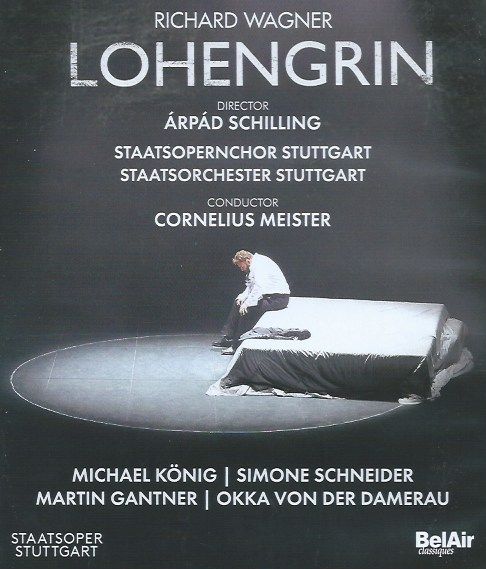A 'Lohengrin' from Stuttgart

For some, Wagner seems like an unassailable mountain. Where to start? The pre-Ring works seem best; and while both Tannhäuser and Der fliegende Holländer seem fit for purpose, perhaps Lohengrin is the best, for of the three it best introduces the spirituality - and the inspired music that emerges later in such perfect form in Parsifal.
According to Wagner's instructions, Lohengrin is set in Antwerp around the year 900. The Duchy of Brabant is in turmoil; Elsa is accused of having murdered her brother, Gottfried (he was actually enchanted by the evil Ortrud). Elsa can only defend herself by speaking of a dream of a knight who will be her saviour; he (whom we know to be called Lohengrin) appears on a boat drawn by a swan, promising to marry her as long as she does not ask his name or from whence he comes.Act II finds Ortrud and her husband swearing vengeance. Ortrud and Telramund try to stop the wedding of Elsa and Lohengrin by a series of accusations; Elsa sticks to her faith in Lohengrin. In the final act, alone together, Elsa finally asks Lohengrin his name. He explains he has been sent by the temple of the Holy Grail in Monsalvat. His father is Parsifal (or "Parzifal," as it is sung here).
Of course, when we work with visual releases, we encounter the production. Today's is a Lohengrin from Stuttgart (which opera house clearly has excellent orchestra and chorus) from Árpád Schilling. One of the most famous passages in Lohengrin is when the titular hero leaves at the end, on a swan (symbol of purity and mysticism).So, in this production, where's the swan? Everyone likes a swan in Lohengrin, perhaps because of the lingering hope that the hero might miss it and have to wait for the next one ....
But modern opera productions don't take things the composer wished as (pardon the pun) the holy grail. Lohengrin enters from within a crowd (instead of diembarking from a boat pulled by a swan), all clad in similar, grey clothing. As often in Wagner, names are important in and of themselves, and it is part of Lohengrin's mission on behalf of the Holy Grail that he does not reveal his name; hence the anonymity in the production, the one from emerging from the masses. Director in Stuttgart Árpád Schilling's take centres on the individual versus the collective; the "higher" aspects (Lohengrin as son of what is here given as "Parzifal," a lineage revealed as he reveals his name at the very end of the evening; the purity of the swan - remember Parsifal shoots one and is reprimanded by Gurnemanz at his first entrance in Parsifal) are perhaps minimised.
The Herald (Herrufer) is dressed differently from the crowd; it could be in a grayed-out circus master's outit, or some sort of variant on formal gown. When four girls come in with "Macht Platz" we get our first colour (and they sound GREAT). We do get model swans, though, in the second act on a river made out of a blue curtain; but the in final act when we hear the Bridal Chorus off-stage, we just see a plinth with a cloth over it and a circle of light on it (the circle, at once symbol of eternity but also of exclusion, is a major symbol in thsi production). The Lohengrin/Elsa scene is effectively in black and white, enacted over that plinth/bed, Elsa in bridal white, Lohengrin in black and white, his gray jacket to one side. Minimal, indeed, but it does mean we can concentrate on the singing: and tenor Michael König is in fine form. When the army of on-stage trumpeters are dressed ina non-committal dark green, as if they too want to merge into a. collective; it is only when the Volk (the people) arrive that colour is finally seen, an extension of the men taking off their gray suits in the second act to reveal everyday clothes underneath: the individual is born. The "swan" of the ending is a model swan which Elsa takes from underneath her raincoat. Towards the end, Lohengrin's text refers to a horn, a sword and a ring, all of which are absent.
The final director's tweak is very much of this interventionalist bent: Lohengrin leaves, as he has to by his oath. This leaves the Volk without a leader and, returning to a collective voice, they turn menacingly on Elsa, now an outcast with only a small knife to protect her.
Here is a teaser for the production:
Lohengrin sings his some of his great final monologues sitting on the edge of the bed, more a reflection, or even a bedside story to a collective, than a heroic tale. No doubting Michael König has the vocal strength, though; this is beautiful singing. With Simone Schneider's radianty sung Elsa von Brabant and Okka von der Damerau's strong Ortrud, this is, musically, a Lohengrin to savour. Maybe the true star is Stuttgart's Staatsoper chorus, one of the finest I have heard.
In the absence of an excerpt from this production, let's hear one of the great Heldentenors ("heroic tenors") of the past, Lauritz Melchior, in the third act "Mein lieber Schwan":
Like the Ring, Lohengrin can be seen spiritually or politically. This Stuttgart production is heavy on the political; and it is shot through with fine singing and conducting. Cornelius Meister is a brilliant young conductor, and his enthusiasm for the score as he recounts his experiences in the following video (for German-speakers only - there are no subtitles, unfortunately) is palpable:
I have given links for both DVD and Bluray below: but I have to say, the definition on the Bluray is simply fabulous.
